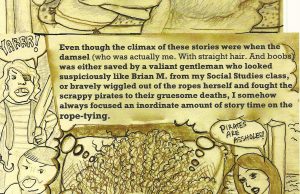Putting the “X” in X-Men
Last week, Ta-Nehisi Coates wrote a fascinating editorial-cum-review of Matthew Vaughan’s X-Men: First Class in The New York Times. In it, he makes an important point about the absence of the Black Freedom Movement from the film’s narrative:
as “First Class” roars to its final climactic scene, it appeals to an insidious suspension of disbelief; the heroic mutants of America, bravely opposing bigotry and fear, are revealed as not so much a spectrum of humankind, but as Eagle Scouts from Mayfield. Thus, “First Class” proves itself not merely an incredible film, but an incredible work of American historical fiction. Here is a period piece for our postracial times — in the era of Ella Baker and the Rev. Dr. Martin Luther King Jr., the most powerful adversaries of spectacular apartheid are a team of enlightened white dudes.
This rewriting exercise is made more significant because
“First Class” is set in 1962. That was the year South Carolina marked the Civil War centennial by returning the Confederate Flag to the State Capitol; the year the University of Mississippi greeted its first black student, James Meredith, with a lethal race riot; the year George Wallace was elected governor of Alabama.
And for Coates, the movie marks the latest example in a long pattern of deliberate amnesia:
I am reminded of the House Republicans, opening the 112th Congress by reciting the Constitution, minus the slavery parts. I am reminded of the English professor last year who, responding to Huckleberry Finn’s widespread banishment from public schools, was compelled to offer the Mark Twain classic, minus the nigger parts. I think of the Pentagon official, who this year justified the war in Afghanistan to soldiers by invoking the words of Dr. King, minus the “ultimate weakness of violence” parts. I am reminded of whole swaths of this country where historical fiction compels Americans to claim the Civil War was about states’ rights, minus the “right to own people” part.
When I first read the article, these words made a lot of sense. If it was about several other movies, they still would. If it was a general piece about cultural whitewashing, I’d be in complete agreement. Because on this larger point, Coates is perceptive and absolutely correct. The practice he identifies, by which history is sanitized and simplified, is just as prevalent, cynical, and dangerous as he suggests. But on a second reading, I’m just not sure how well X-Men really fits the trend.
For anybody who has not seen it yet and doesn’t mind a spoiler, a brief synopsis: It tells the story of mutants gifted with phenomenal powers before they became the X-Men, centering on the friendship of Erik Lehnsherr (Michael Fassbender), who will become “Magneto,” and Charles Xavier (James McAvoy), who becomes “Professor X.” Xavier is a professor of genetics, blessed with telepathy. Lehnsherr is a Holocaust survivor who can manipulate metal. The movie opens in Auschwitz, where Lehnsherr’s mother is murdered by the villain, another mutant, Sebastian Shaw (Kevin Bacon), in a bid to develop Magneto’s power. It later becomes clear that Shaw dreams of a world free of humans, and with the aid of likeminded mutants, he engineers the Cuban Missile Crisis in the hope of realizing the complete annihilation of humanity. At the movie’s climax, the opposing Cold War superpowers face each other off the Cuban coast. Shaw and World War III are only thwarted by the specialist mutant team assembled by Magneto and Professor X.
While their friendship is heartfelt and mutual, ultimately the two heroes are motivated by different causes. Xavier dreams of a world in which mutant and human coexist peacefully, and defends both equally from violence. For him, preventing nuclear apocalypse is paramount. Lehnsherr, a passionate advocate of mutant rights, is also driven by the desire to avenge his family’s deaths, and ultimately achieves his goal by killing Shaw. However, fearful of the power they have just witnessed, the Soviet and American naval fleets turn their weapons on the mutants who have just saved their lives. Magneto is only stopped from turning the missiles back on humanity and realizing Shaw’s goal by the Professor’s intervention. The movie ends as the former friends part ways: Xavier to found an academy for mutants and work towards human-mutant cooperation; Magneto to take up Shaw’s nationalist mantle by resisting persecution of mutants by any means necessary.
X-Men really is “an incredible work of American historical fiction.” But “fiction” is the key word here, in that parts of the film correspond to real events and people, but it is not meant to be an authentic representation of our past. Granted, the line between fact and fiction is fluid—the historical record is by no means a pure unmediated narrative of what happened. Nonetheless, there’s a case to be made for a separation between movies that lay claim to a historical reality its audience broadly understands as truth, and those that reimagine those events in an exercise of creative fantasy. X-Men: First Class falls into the latter category.
To my mind, something like Roland Emmerich’s The Patriot (2000), a movie that marketed itself on authenticity—so much so that it called in the Smithsonian to ensure Gullah village huts were built from accurate materials—yet completely glossed over slavery in Revolutionary era South Carolina, falls into the former. One freedom fighter even assures the film’s only slave that once the revolution is won, “a lot of things will change. They call this the New World, it’s not. It’s the same as the old. But we’ll have a chance to build a new world. A world where all men, and women, are created equal under God.” But the actual failure of the nation’s founders to live up to such rhetoric by ending slavery is completely ignored. What makes this elision different from X-Men is that The Patriot is not meant to be a different version of American History, it is meant to be our history. The filmmakers, hoping to cash in on patriotic fervor, sought to persuade the audience that the trials the Americans endure on screen are exactly what made their country great.
X-Men is not claiming to represent this kind of “truth.” It might be guilty of “changing” history, but it is not claiming to do otherwise. Our present and its pasts are connected only by fantasy. We can imagine ourselves in a present where mutants can shapeshift, turn themselves into diamond, or teleport. But we are not actually being told, nor do we ever actually think, that we live in that world. By excluding King and Baker, Vaughan isn’t telling us that we’re the products of a time in which these figures or the movement they worked for never existed. X-Men may require suspension of disbelief about mutants with superpowers, but there is no intent to persuade us that they existed and fought bigotry in the place of black activism. In this way at least, a difference between “fact” and fiction remains.
On the other hand, intentionality isn’t everything. No matter how much X-Men is not meant to be a comment on the past, it still says something about the present. Coates is right that even if the filmmakers thought the Black Freedom Movement was irrelevant to their particular imagined world, it is worrying that they (correctly) assumed an audience is far more comfortable watching characters espouse hatred if they are Nazis than Americans, and show militant defiance to bigotry if they are white. But there are other reasons why the protagonists are “enlightened white dudes.”
The Magneto of the original graphic novels was a victim of the Holocaust, and not chattel slavery or Jim Crow. To depict him in this way now might please some, but it would likely alienate a significant fan-base for whom the franchise has been an informative tool and source of inspiration. Magneto’s passionate resistance to mutant persecution, like that of Professor X, is a parable that could give comfort, if only in the reader’s imagination, in the hardest of realities.
And it’s more accessible than most protest narratives. As Coates says, both he and his son “were united across the ages in our love for the X-Men — patron-saints of the persecuted and the champions of freaks and pariahs across the globe.” As such, it seems unlikely that the average X-Men fan would be alienated by a black hero per se. Instead they would object to a white character—and we can say “white” only by conventional phenotypical standards; as a Jew under Nazi rule, Magneto hardly has access to the privileges of whiteness—being made black in an act of tokenism. Such an act would remove the Holocaust from twentieth century history, an alternative no better than the one Coates criticizes. There is no monopoly on the experience of racism, and at least in this version some of the graphic novel’s original integrity is maintained. Considering that the Holocaust itself is not the main setting or focus, to swap it out for a segregated South that would only serve as a backdrop would not do justice to complex episodes of the past, or their legacies today.
More problematic than the absence of African Americans is how they are treated when present. It says even more of current popular culture that a movie about resistance to othering employs a cinematic trope so clichéd that Wes Anderson’s Scream grew self-referential about it fifteen years ago. One of only two mutants we might identify as black, Darwin (Edi Gathegi), dies first. (The other, Angel, played by Zoë Kravitz, is distinguished only by her decision to leave the X-Men to join Shaw’s side). In fact, Darwin is the only mutant other than the main villain to die at all. A character that never appears in the comics is created, cast with a black actor, and killed off at the first opportunity. Tokenism is rarely so unsubtle, but, as ever, it draws attention to representative traditions in popular film that are still prevalent long after they should have been abandoned.
Even if we can find fault with the way X-Men deals with black history, we cannot say it is not present at all. Because although Ella Baker might be completely absent—as she, and other female leaders like Fannie Lou Hamer, Elaine Brown, or Kathleen Cleaver all too often are from even the most academic narratives of the Movement—some of the male leaders are on screen. The leads may be “enlightened white dudes,” but ever since the characters were created, they have represented more. Professor X, who espouses integration, is meant to be King. Magneto, an advocate of mutant nationalism, symbolizes Malcolm X. This is made particularly obvious in the 2000 X-Men movie, when (played by Ian McKellan in this version) he even uses Malcolm X’s dictum “by any means necessary” to describe his policy of resistance. Like Malcolm X, his life is in part defined by the racially motivated murder of a parent, and he continually reinvents himself. Even the “X” in X-Men, while a reference to Xavier’s name, also signifies the liminal social space that the mutants occupy and Malcolm embraced when he relinquished his original last name.
However, we cannot cleave to this analogy too closely. Professor X, even if he doesn’t use violence himself, allows his followers to do so when it’s essential; King never did. Magneto is willing to kill all humans in 2006’s X-Men: The Last Stand; Malcolm advocated violence only when absolutely necessary, and never argued for killing whites on principle, only for matching force with force. We should avoid attempts—and they have been all too common—to demonize him as a man consumed by violent hatred of whites. The comparison is meant to be a loose one.
What is most striking about the King-Malcolm X symbolism though, is that X-Men, especially in this most recent incarnation, displays a high level of sympathy towards the Magneto-Malcolm X character. Even when Magneto plays the villain in previous movies, we notice a level of equivalence between him and King-Professor X. In First Class their relationship seems even closer. We understand Lehnsherr to be just as passionately committed to mutant rights as Xavier.
When Magneto extracts his revenge on Shaw, when he argues for open defiance against persecution, when he tells the shapeshifter, Mystique (Jennifer Lawrence), that she is more beautiful in her natural blue form than when pretending to be human—a reference to the Black Power era “black is beautiful” mantra—the audience sympathizes with him. When his prediction that humans will persecute mutants comes true, our sympathy is further vindicated. How many popular sources, other than the autobiography co-written with Alex Haley and Spike Lee’s 1992 biopic, view Malcolm X in anywhere near such a balanced and respectful light? As the late Manning Marable suggests, if Malcolm is embraced by a white readership, it is usually a version of him that focuses on his late conversion “to what might be called multicultural universalism,” not his fierce defiance of institutional racism (8-9). X-Men bucks this trend.
Even if the symbolism of the MLK-Malcolm X relationship is too obscure, even if we accept Coates’ charge that the movie is portraying our past conveniently free of blackness, we can acknowledge the presence of the integration vs. militancy dichotomy that runs through all the movies. Once we do, it is possible to use X-Men: First Class as a “teachable moment.” Rather than dismiss it as a whitewashed version of history, we should use it to reformulate conversations about the Black Freedom Movement. We should certainly question, as Coates does, why a version of Malcolm X is more palatable in this form, and we should not let the movie take the place of sustained attempts to understand his ideological legacy. But we should also acknowledge that in some ways, the movie reveals Malcolm’s continued relevance. Just, as William W. Sales points out, Malcolm became a symbol of defiance for black youth in early 1990s hip-hop, so might he now for a larger demographic through popular film. If viewers of the movie find it more accessible than conventional history sources, why not utilize that accessibility? Why not make it an entry point into more developed studies of King and Malcolm X that are not sanitized, cynical, or distorted? This marks the perfect opportunity to explore Marable’s recent biography, which tells us that after Malcolm was assassinated, “it would take most of white America almost three decades to alter its perceptions” of him as a “dangerous demagogue” (13). It is interesting to note though that ever since his first appearance in print in 1963, two years before the assassination, a somewhat sympathetic reading of Magneto—one that does not ignore his will to resist—has had traction with a predominantly white audience, however small it might be. This continued prevalence in popular culture deserves greater analysis than Coates allows. As Marable also says, Malcolm
always assumed an approachable and intimate outward style, yet also held something in reserve. These layers of personality were even expressed as a series of different names…Malcolm Little, Homeboy, Jack Carlton, Detroit Red, Big Red, Satan, Malachi Shabazz, Malik Shabazz, El-Hajj Malik El-Shabazz. No single personality ever captured him fully. In this sense, his narrative is a brilliant series of reinventions, “Malcolm X” being just the best known. (10)
When we address this accessible yet enigmatic personality, and consider (without ignoring) its influence beyond the realm of black grassroots politics, perhaps we can add “Magneto” to this long list of reinventions. A movie about mutation and shapeshifting is, after all, concerned with just that.
Manning Marable, Malcolm X: A Life of Reinvention (New York: Viking, 2011).
William W. Sales, Jr., From Civil Rights to Black Liberation: Malcolm X and the Organization of Afro-AmericanUnity (Boston: South End Press, 1994).





0 comments